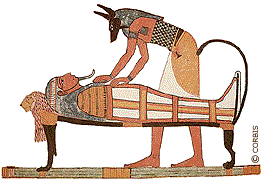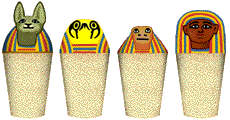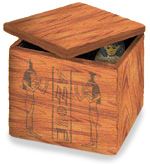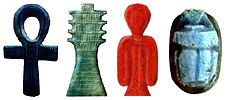The mummification
process
Eventually, someone realized that the trick for having
deep elaborate burials but still maintaining a recognizable
body was to preserve the dead before burial. They
experimented with different techniques and finally
discovered a method of mummification that was so effective
that many of their mummies are still wonderfully preserved
today!
Making mummies turned out to be not so complicated after
all- the Egyptians simply intentionally dried the bodies
first, then added the linen, resin, coffins, and deep
tombs.
 The
entire process of mummification took 70 days to complete.
Several embalmers conducted the task in the special
embalming shop or per nefer. The chief embalmer was
known as the hery seshta. He wore a jackal mask to
represent Anubis, the god of mummification. Assistants
called wetyw bandaged the body and carried out other
tasks of the embalming process.
The
entire process of mummification took 70 days to complete.
Several embalmers conducted the task in the special
embalming shop or per nefer. The chief embalmer was
known as the hery seshta. He wore a jackal mask to
represent Anubis, the god of mummification. Assistants
called wetyw bandaged the body and carried out other
tasks of the embalming process.
After being delivered to the per nefer, the first task
that needed to be done was to remove the soft, moist body
parts that would cause decay. One of the embalmers would use
a knife to make an incision in the left side of the abdomen.
Although this step was entirely necessary to remove the
organs, they didn't like it because it was considered sinful
to "injure" a corpse. The other embalmers present would
curse and throw stones at the man who made the cut. They
weren't really trying to hurt him, it was all just a
symbolic part of the ceremony.
The stomach, intestines, liver, and
lungs were removed and preserved by drying them in a special
salt called natron. Natron is chemically similar to a
mixture of table salt and baking soda. Originally dissolved
in the ground water, it is found in clumps by oases where it
gets left behind when water evaporates.
Once thoroughly dried, the organs would be put into
separate containers called canopic jars. The
Egyptians believed that all body parts would be magically
reunited in the afterlife and the body would become whole
again, just like the god Osiris. According to Egyptian
mythology, the god Osiris was murdered by his jealous
brother Set and hacked into pieces. The goddess Isis
reassembled the pieces and Osiris was magically restored,
and went on to become the god of the afterlife.
The stoppers of canopic jars were shaped like the heads
of the four sons of the god Horus. Each son protected the
organ placed inside his respective jar. Duamutef, who had
the head of a jackal, guarded the jar that contained the
stomach. Qebehsenuf, who had the head of a falcon, watched
over the intestines. Hapi, the baboon-headed son of Horus,
protected the lungs, while human-headed Imseti was in charge
of protecting the liver. Canopic jars were usually stored in
a chest that was later placed in the tomb with the
mummy.
|

|
|

|
Although it didn't get its own canopic jar, the brain was
another organ that was taken out of the body. The bone that
separates the nasal cavity from the brain was broken open by
ramming a sharp instrument up the nose. Next, a long hook
was used to stir up the brain until it was liquefied. Then
the embalmers would turn the body face down to allow the
brain to ooze out the nostrils. The Egyptians were so rough
on the brain because they didn't realize its importance.
They thought its sole purpose was to produce snot!

brain removal
hook
After all the organs were removed, the body was washed
with wine and rubbed with spices. The alcohol in the wine
acted as an antiseptic, helping to kill bacteria. The corpse
was then covered with natron for 40 days to dry out. Once
dried, the skin was shrunken, wrinkled, and leathery. The
mummy was cleaned one more time and rubbed with sacred oils
to soften the skin.
In one Egyptian myth, the god Horus had his eye
miraculously restored after losing it in a battle with the
evil god Set. The Eye of Horus, called a wedjat, is
associated with healing and protection. A wax or bronze
plate with a wedjat carved on it was placed over the
embalming incision to magically heal the gash in the
afterlife.

bronze wedjat
After the body was fully dried and cleaned, it was
adorned with jewelry. Then it was covered in linen shrouds
and bound with linen strips. During some time periods, the
name of the mummy would be written on the ends of the
bandages- an ancient practice that has helped modern
Egyptologists identify certain mummies! When the Greeks and
Romans occupied Egypt in the very late periods of its
history, arranging the linen wrappings in neat geometric
patterns was popular.
Small magical amulets were inserted
between the layers of the bandages to further protect the
mummy's spirit on its way to the afterlife. As each layer
was added, it was coated with resin to hold the wrappings
together with a waterproof seal.

some funerary amulets:
ankh (symbolizes life); djed (for strength
and stability); tet (protects the limbs); and a scarab
(symbolizes rebirth)